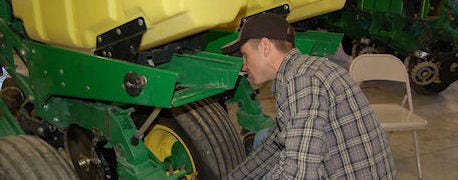
We've been in toolshed and seen old planter parts cast off to the side. We've seen planters with one side rebuilt and the other yet to go. We've also seen planters getting all kinds of new technology tacked on to see if it's possible to learn more about doing a good job of planting. And we've seen sprayers getting a re-work, with old nozzles strewn on a workbench and new nozzles on the boom.
If you're in the process, or even if you think you're done, here are some ideas to think about.
Planting

Time to make sure planter and sprayer are ready for the season ahead.
-If you've added automatic controls, switched from finger-pick-up to an air system, or if you've added a system that controls residue wheels automatically, do you have enough hydraulic pressure on the tractor you're pulling it with to make it all work? One farmer found out the hard way last year that he didn't. You might ask your dealer. A lot of it may depend upon the age of the tractor.
-Are your seed disks worn, or still in good shape? On some planters if the seed disks wear too far, you get a 'w' groove instead of a 'v' groove. The 'v' groove is much more desirable for getting the proper depth and consistent seed placement.
-If you've installed new gadgets, say Field View from Precision Planting, to go along with the Precision Planting 20/20 Seed Sense monitor, have you tested them as best as you can in the shop or barn lot? Have you read the manuals?
-Maybe you've added a downpressure system that works off air generated by an air compressor. There is more than one brand on the market. Have you reviewed the manual to make sure you know how it operates?
-Are you willing to run a vertical tillage tool over the field lightly, or are you going to wait until the soil dries on its own? There are sensors that can pick up soil compaction. Have you already probed fields to see where you may have layers?
-Have you gone through each row unit from front to back, checking Keeton Seed firmers to closing wheels for wear?
Spraying
-Have you checked your nozzles for wear? Newer materials wear longer, but at some point they must be replaced. Greg Lundquist, AgroChem, Wabash, says 10,000 acres is often the breaking point on wear.
-If you're spraying residual herbicides and haven't before, have you considered an injection system to keep soil-applied products out of the main tank and avoid mixing issues? Some sprayers come with them standard. You can add them on to other sprayers.
-Have you walked behind the sprayer while it's operating to make sure the pattern is correct? Have you calibrated the sprayer to make sure it's delivering the right volume?
-How will you keep track of sprayer pressure? Does your sprayer have a read-out that's easy to watch, either in the cab on a self-propelled sprayer, or in a convenient place on a pull-type sprayer?
-Have you boned up on weed identification? Will you know regular pigweed from waterhemp? Do you know at what size each should be sprayed according to the label? Catching them in the right time window is crucial.
-If you're bringing water or herbicide to the field, is the vehicle you're using free of leaks and in top condition? Have you went over it a second time just in case. Plastic poly water tanks that ride to the field sometimes develop 'checking', which means the tank is weak and could break or be broken more easily.
About the Author(s)
You May Also Like




